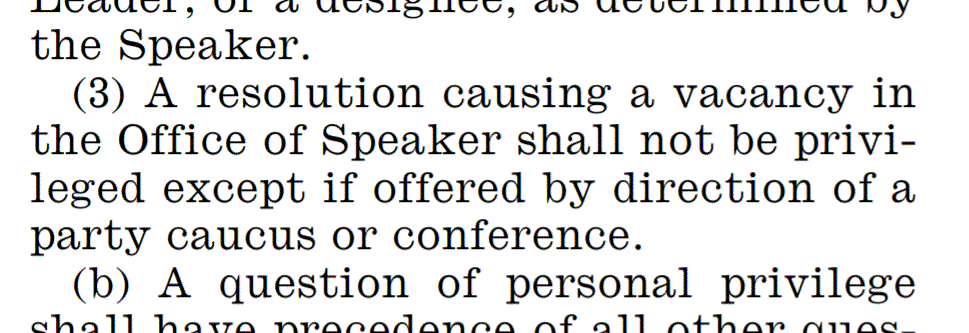
On Wednesday night, the news broke that members of the Freedom Caucus, a conservative faction of the House Republican Party, were urging Minority Leader Kevin McCarthy (R-CA) to use a procedural motion that – if approved by a majority of the House – would remove Nancy Pelosi (D-CA) as Speaker. Though McCarthy was noncommittal about the idea, he agreed to convene a meeting of House Republicans to debate it.
If McCarthy and House Republicans agree to offer the motion (known as a motion to vacate the chair), their odds of success are abysmally low. Republicans are the minority party, after all, and few if any Democrats are likely to vote for it. So why did the Freedom Caucus suggest such a long-shot gambit?
The most obvious reason is that the Caucus hopes it will yield electoral gains in Congress. Though its members are in (mostly) safe districts, some House Democrats are not so fortunate. As Politico’s Melanie Zanona and John Bresnahan write, by “mak[ing] support for Pelosi a problem for Democrats in key swing districts…hard-liners believe a vote on the motion to vacate right before the November election would give the issue new life.”
Another possibility, however, is that the Freedom Caucus has its eye not on congressional races but the upcoming presidential election. Congressional parties have tried to nationalize the speakership in campaigns for decades (see for instance this famous anti-Tip O’Neill ad from 1980). By bringing up a motion to vacate the chair just weeks before Election Day, the Caucus may hope to bring attention to a polarizing Speaker and redirect a campaign narrative that has been largely harmful to President Trump.
If so, the proposal is important for two reasons. First, it underscores how the Freedom Caucus – once a group known for using hardball tactics against its own party’s leaders, including using the motion to vacate the chair against Speaker John Boehner in 2015 – has aligned itself with the Trump White House. It would be just the latest example of how the Caucus has tried to help the president, influence his tactics and agenda, and attack his critics, even those within the GOP.
Second, if Republicans do offer the motion, it could further accentuate the partisan nature of the Speakership and diminish its traditional non-partisan roles. This is not just because Republicans would be trying to remove a Democratic Speaker. It would also affirm something implied by a recent change to House rules: namely, that the motion to vacate the chair is an attractive messaging tool for the minority party to question the Speaker's legitimacy.
Before last year, the rules of the House gave any individual legislator, regardless of party, the right to offer a privileged motion to vacate the chair. This embodied the principle that a single lawmaker should be able to keep the Speaker accountable to a majority of the whole House. This long-standing principle was explained by Speaker Joe Cannon (R-IL) who, facing a revolt on the House floor in 1910, refused to resign but declared that “under the Constitution it is a question of the highest privilege for an actual majority of the House at any time to choose a new Speaker” (emphasis added).
The motion to vacate the chair is seldom offered. But five years ago, when the Freedom Caucus (or at least some of its members) suggested they would use it against Speaker Boehner, it revealed a potential problem with the motion: factions within the majority party could hold Speakers hostage by credibly threatening to oust them with a cross-party coalition that included the minority party.
To prevent this outcome, in January 2019 House Democrats passed a package of chamber rules that included new text making the motion privileged only “if offered by direction of a party caucus or conference.” The new rule successfully took power away from dissenters within each party, ensuring some leadership stability and helping keep intraparty fights off the House floor. (This is why Freedom Caucus members had to appeal to McCarthy first, rather than offer the motion themselves.)
However, since it is exceedingly improbable that the governing party would ever try to remove a sitting Speaker, the rule change created another possibility: that the motion to vacate would be converted into an exclusively minority party instrument. And while minority parties can’t pass the motion on their own, they can still offer it to achieve other, more partisan symbolic purposes.
For example, a minority party could offer a motion to vacate the chair for position-taking, to show like-minded voters that it dislikes the Speaker and to make vulnerable majority party members cast a politically difficult vote. Leaders of minority parties may also be incentivized to use the motion as a method of shoring up their support within their own party. Zemora and Bresnahan note that, for McCarthy, the motion “would help him earn major points with House conservatives, whose support will be crucial in any leadership bid post-November.”
The danger, then, is that if House Republicans adopt the Freedom Caucus’ tactic, it would establish a precedent that the motion to vacate the chair is not a mechanism of accountability but rather a device to be cynically employed for partisan gain. Used often enough, the motion would further divide the two parties and suggest that the Speakership, already a partisan post in many ways, is illegitimate in the eyes of the minority and can only represent one party, not the entire chamber.
In the short run, the Freedom Caucus’ plot is unlikely to go far, especially if the House GOP agrees with Matt Glassman that the motion won’t be noticed by anyone other than the party’s already fired-up base. But should other House minority parties have less compunction about using the motion to vacate, it may have major consequences for party relations and may raise doubts about whether the Speaker still has any non-partisan role to play in Congress.
